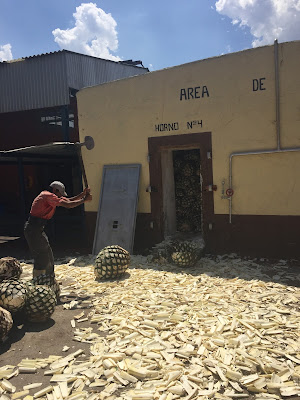Leaving the Palouse to Explore the Land of Agave
By Maggie Elliot
Eight students and 2 faculty members from the College of
Agricultural and Life Sciences undertook a study abroad trip to Guadalajara,
Mexico over spring break. I had the pleasure of joining the team of Vandals to explore agriculture in the region surrounding the city of Guadalajara.
Guadalajara is a city in the state of Jalisco, Mexico.
Agriculture is a primary source of employment in Jalisco, as the state produces a fifth of the entire
nation’s dairy, poultry, and eggs, and is at the heart of the tequila industry.
The trip was operated in conjunction with the Universidad Autonoma de
Guadalajara, and we interacted with students daily as they drove us to our locations.
We visited food processing plants, a dairy, research
facilities, a hydroponic nursery, and a tequila distillery.
A recurring theme of our visit was the adaption of regional
agriculturists to climate change, as Jalisco’s proximity to the equator
accentuates it's effects. The area has been experiencing
unpredictable precipitation patterns, with increased flooding and longer
periods of drought. The drier periods make the land vulnerable to forest fires,
which have had serious consequences.
One of the main takeaways I took from the trip was the
innovative ways agriculturists around the world are confronting their
challenges. Whether it is climate change or market instability, agriculture is
a discipline with hardworking and insightful professionals dedicated to overcoming present obstacles.
Another key takeaway? How tequila is made.
Growing up surrounded by vineyards and hopyards, it was a facinating experience to learn about the production of tequila.
We spent one morning at the Tequila Regulatory Board,
an entity committed to ensuring the quality of tequila. Samples from every batch of tequila are sent to the regulatory board and tested for impurities and health hazards. Even the isotopes of the agave plant are examined, and using the final product of tequila, scientists can distingush which specific area the agave was grown.
 |
| To become certified tequila, the product must undergo a series of tests |
The name "tequila" is protected by an appellation of origin,
meaning the product must meet specific standards and is defined by geographic
location. Just as champagne can only come from the Champagne region of
France, the agave to make tequila can only be grown in certain regions of the
country.
Tequila is the fermented and distilled juice of the blue agave plant which resembles a cactus, but is
actually a succulent.
 |
| Agave harvesting has not been mechanized, making it a labor intensive crop. |
The size of the agave head is not an indicator of maturity,
instead growers focus on it's sugar content. 24% sugar is the minimally accepted percentage
to harvest. The degree of ripeness preferred fluctuates between distillers; as
underripe agave will produce tequila with vegetal notes, while overripe agave will produce sweeter and more well rounded flavors.
 |
| Chopping a pina to load into the oven |
Once the pina is harvested, the remaining shoots
are sliced off, leaving only the core. The pina is chopped in half for uniform
cooking and steam baked for 26 to 28 hours at 230 degrees Fahrenheit. Slow cooking is necessary, because the heat hydrolizes the agave insulin into
fructose, a fermentable sugar.
The pina is shredded, pressed, and filtered for maximum extraction. The agave juice is ready to be
fermented, and at this step in the process other sugars from corn or cane may
be added, depending on whether the product is tequila or 100% agave tequila.
The strain of yeast used have a determining factor on the
inherent taste of the finished tequila. Spontaneous fermentation using airborne
yeasts is the traditional method, however larger distillers have developed
proprietary strains. La Casahuin, the distillery we visited, uses spontaneous fermentation.
 |
| Climbing up to the vats |
 |
| Vats remain open at the start of fermentation to promote aerobic respiration, encouraging yeast cells to multiply |
Fermentation of the agave juice takes one to three days, and produces an initial wash with 4-6% alcohol. This product must be distilled two times,
deriving a spirit 55-75% alcohol.
“Blanco” tequila is sold without contact to a barrel, but
aged and extra aged tequila are matured in barrels of French or American oak to
impart softer tannins to the final product. Casahuin purchases toasted barrels from Jack Daniels.
As we finished the tour and walked by a pile of pinas ready to be split and baked, the owner paused, smiling. "I hope you can appreciate the smell of the ripe agave." He closed his eyes and drew a deep breath. "It's the best smell in the world."
On this trip I learned that there is something special about agriculture that connects people.
Even with a language barrier present, all it takes is asking about the specifics of docking the tail of a lamb, a fertilizer regimen for hydroponic arugula, or benefits of planting a native plant as a cover crop to see people’s eyes light up and know an instant connection is forged.
No matter where you are from, agriculture instills an intrinsic connection to the land and pride in the legacy of labor. It weaves a thread of family traditions, while fostering an unmistakable drive to advance and improve. I learned that whether you are farming potatoes in the Pacific Northwest or blue agave in the Los Altos highlands, the best aspects of agriculture never change.


Comments
Post a Comment